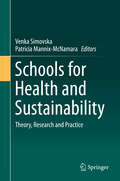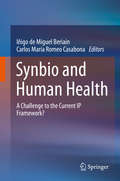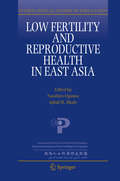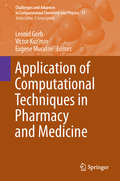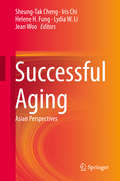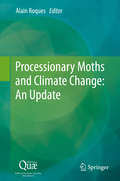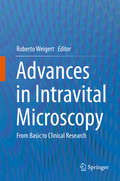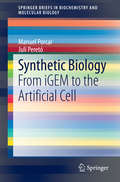- Table View
- List View
An Introduction to Medical Teaching
by Kathryn N. Huggett William B. JeffriesFew faculty members in academic medical centers are formally prepared for their roles as teachers. This work is an introductory text designed to provide medical teachers with the core concepts of effective teaching practice and information about innovations for curriculum design, delivery and assessment. It offers brief, focused chapters with content that is assimilated easily by the reader. The topics are relevant to basic science and clinical teachers and the work does not presume readers possess prerequisite knowledge of education theory or instructional design. The authors emphasize the application of concepts to teaching practice. Topics include: Facilitating Student Learning; Teaching Large Groups; Teaching in Small Groups; Flipping the Classroom; Problem-Based Learning; Team-Based Learning; Teaching Clinical Skills; Teaching with Simulation; Teaching with Practicals and Labs; Teaching with Technological Tools; Teaching to Develop Scientific Engagement in Medical Students; Designing a Course; Establishing and Teaching Elective Courses; Designing Global Health Experiences; Assessing Student Performance; Documenting the Trajectory of Your Teaching and Teaching as Scholarship. This is a complete revision of the first edition of this work with new chapters and up to date information. Similar to the first edition, chapters were written by leaders in medical education and research who draw upon extensive professional experience and the literature on best practices in education. Although designed for teachers, the work reflects a learner-centered perspective and emphasizes outcomes for student learning. The book is accessible and visually interesting and the work contains information that is current, but not time-sensitive. Each chapter concludes with references, many include recommendations for additional reading, and the work includes an appendix with resources for medical education.
Translation and Its Regulation in Cancer Biology and Medicine
by Armen ParsyanThis book, for the first time, comprehensively assembles and analyzes a large body of information on the role of the fundamental mechanism of the protein biosynthesis pathway, translation, in cancer biology. It systematically explores the function of the translation machinery and its regulation, including cell signaling, in the development, maintenance and progression of human cancer. The work presented here unveils the tremendous potential and applications of this vast and exciting branch of genetic, biochemical and molecular science in cancer medicine and drug development.Chapters contributed by experts in the field take the reader on a journey that starts with a dissection of the translation machinery and its regulation in norm and cancer. Later chapters characterize etiological and pathogenetic roles that translation plays in specific cancer types. Various aspects of diagnostic, prognostic and therapeutic significance of the translation machinery and its control in cancer are discussed. Readers will discover the importance of the process of translation and its regulatory mechanisms in physiology and cancer biology.The chapters and the numerous illustrations included here were contributed by expert scientists and clinicians from renowned academic and clinical establishments in Canada, the United States of America, the United Kingdom, Italy, France, Belgium, Spain, Germany and Australia.The book conveys information and knowledge that may interest a broad range of students and scholars ranging from basic scientists to clinicians and drug developers seeking to better understand the protein synthesis and its aberrations in cancer biology and cancer medicine.
Sedation at the End-of-life: An Interdisciplinary Approach (Philosophy and Medicine #116)
by Paulina TaboadaThe book’s main contribution is its interdisciplinary approach to the issue of sedation at the end-of-life. Because it occurs at the end of life, palliative sedation raises a number of important ethical and legal questions, including whether it is a covert form of euthanasia and for what purposes it may legally be used. Many of the book chapters address the first question and almost all deal with a specific form of the second: whether palliative sedation should be used for those experiencing “existential suffering”? This raises the question of what existential suffering is, a topic that is also discussed in the book. The different chapters address these issues from the perspectives of the relevant disciplines: Palliative Medicine, Bioethics, Law and Theology. Hence, helpful accounts of the clinical and historical background for this issue are provided and the importance of drawing accurate ethical and legal distinctions is stressed throughout the whole book. So the volume represents a valuable contribution to the emerging literature on this topic and should be helpful across a broad spectrum of readers: philosophers, theologians and physicians.
I Domain Integrins (Advances in Experimental Medicine and Biology #819)
by Donald GullbergThe integrin family is composed of 24 members and approximately ten years ago (2003) we published a book devoted to the nine I domain integrin subunits. In this second edition, I am pleased that most of the original authors have been able to contribute to the updated version.I domain containing integrins include collagen receptors and leukocyte receptors. In 2003 the knockout mouse phenotypes for all of the I domain integrins had not yet been published; they are now, and are summarized and discussed in this edition.Interestingly, a recent 10 integrin mutation in dogs has indicated that collagen-binding integrins in the musculoskeletal system might have much more severe phenotypes in larger animals/humans compared to the mild integrin phenotypes observed in collagen-binding integrin deficient mice. This finding is further discussed in the book.In the cancer field, the microenvironment is taking center stage, and here collagen receptors on fibroblasts are predicted to play important roles in paracrine signaling, in regulating tissue stiffness and matrix remodeling.New technologies, new mouse models in combination with analyses of I integrins in larger animals/humans are thus predicted to increase our knowledge about this group of receptors. With this in mind we look forward to another 10 years of research with I domain integrins.
The Conquest of Cancer: A distant goal
by Guy FaguetBased on 30 years of clinical and research experience, backed by a careful assessment of four decades of published data, Dr. Faguet documented in The War on Cancer (Springer 2005), early advances in cancer treatment and patient survival that soon stalled. Ten years later and after an exhaustive analysis of evidence-based data available through 2013 that incorporates 755 references, he reveals the root causes of the stagnation in cancer control, including the role played by major stakeholders and advocates a coordinated national effort, akin to the Apollo program, to unveil the causes of cancer and their mastery. In the interim, Dr. Faguet urges caregivers to manage patients according to the four ethical principles of beneficence, non-maleficence, respect for patients’ autonomy and justice especially at the end of life.
Circulating Nucleic Acids in Early Diagnosis, Prognosis and Treatment Monitoring: An Introduction (Advances in Predictive, Preventive and Personalised Medicine #5)
by Peter B. GahanDNA and RNA fractions can be isolated from a variety of body fluids including whole blood, serum, plasma, urine, saliva and cerebrospinal fluid from both patients and healthy individuals. Such isolates can be exploited in the early detection of clinical disorders, stratification of patients for treatment, treatment monitoring and clinical follow-up. In addition, the use in fetal medicine allows the early detection of fetal sex, Rh factor and aneuploid disorders as well as following both fetal and premature born infant development. This volume is intended as a primer for those who are interested in entering the field of circulating nucleic acids.The areas covered in this volume include:· Background and general biology of circulating nucleic acids· Methodology· Applications of circulating nucleic acids· Quality Assurance· Ethics
Schools for Health and Sustainability: Theory, Research and Practice
by Venka Simovska Patricia Mannix McNamaraSchools are unique places. They pay a central role in the formation of young people. The importance of how young people are educated and how they are encouraged to live and learn cannot be underestimated. This book advocates for the fostering of agency not only amongst school personnel but also amongst younger generations for health and sustainability. It provides the reader with a new lens with which to discover health promoting schools and education for sustainable development. It invites the reader to look more deeply into both and to accompany the authors on a journey of discovery of the real potential for each to enhance the practice of schooling.
Synbio and Human Health: A Challenge to the Current IP Framework?
by Iñigo Miguel Beriain Carlos María Romeo CasabonaSince 2010, the Inter-university chair in law and the Human Genome has been involved in an EU 7th Framework Programme funded Project called Sybhel, leading work package 5. The aim of this work package was to face the issues related to synthetic biology and intellectual property rights. In these years, the Chair organized two international workshops devoted to this topic, collecting a number of high level unpublished papers redacted by some of the most prominent experts in this field worldwide, including Stephen Maurer, Joachim Henkel, Ingrid Schneider, etc. We consider that it would be extremely interesting to have them all gathered in a unique contributed volume, which would be the first book exclusively dedicated to analyze the implications that Synbio may involve in what refers to the currently existing intellectual property rights system.
Genomics and Proteomics for Clinical Discovery and Development (Translational Bioinformatics #6)
by György Marko-VargaThe book is intended to be a resource for students as well as scientists in education and for the general public to learn about proteomics and genomics. Chromosomes form the basis for our genetic heritage and are the code for protein synthesis. The Human Genome Map came out in 2002, and the Proteome Sequence Map is under currently being created by a global consortia initiative. Proteome and genome building blocks already form the basis of scientific research areas as well as large parts of the pharmaceutical and biomedical industry. The book initiative will provide the background to and our current understanding of these gene and protein areas, as well as describe how cutting-edge science is using these resources to develop new medicines and new diagnostics for patient care and treatment. The book will be useful for undergraduate students as well as university students and researchers who need a good understanding of genomics and proteomics within the clinical field. The book will also be targeted at a broad public as well as readers not specialized within this field.Dr. Marko-Varga is the head of the Head of Div. Clinical Protein Science & Imaging at the Biomedical Center, Dept. of Measurement Technology and Industrial Electrical Engineering, Lund University, and Professor at the 1st Department of Surgery, Tokyo Medical University, Tokyo, Japan.
Mutant p53 and MDM2 in Cancer (Subcellular Biochemistry #85)
by Swati Palit Deb Sumitra DebThis book provides the readers with an overview of research on p53, which has been shown to play a role in numerous crucial biological pathways in normal and cancer cells. Leading scientist in the field, who have all made direct contributions to the understanding of the molecular events underpinning p53 function, have been invited to contribute the various chapters, which discuss the current knowledge of the signaling cascades that are activated by mutations in p53 and overexpression of MDM2, frequently found in human cancer and are major causes of oncogenesis.This book features chapters on the molecular basis of oncogenesis induced by gain of function mutation of p53, signaling pathways induced by MDM2 overexpression, control of mutant or wild-type p53 function by MDM2 and MDMX, p53 mutation in hereditary cancer and structural aspects that activate mutant p53 which can be targeted by drug therapy. This book should be useful for scientists at all levels.
Rare Diseases: Integrative PPPM Approach as the Medicine of the Future (Advances in Predictive, Preventive and Personalised Medicine #6)
by Meral ÖzgüçThis book focuses on predictive, preventative and personalized medicine (PPPM) and how it is related to the healthcare of rare diseases. Readers will discover how advanced rare diseases healthcare provides an excellent “proof-of-principles” for the personalisation of healthcare systems on a global scale. Chapters look at national plans for rare disease, at biobanking, gene identification, rare cancers, virus gene therapy , induced pluripotency for cell therapy amongst other topics. There is a chapter dedicated to personalized medicine for hereditary deafness and another exploring the complexity of genotype-phenotype correlations. Specific diseases such as Fabry's, Gauchers and mitochondrial cytopathies are highlighted and we look at enzyme replacement therapy in lysosomal storage diseases. This work is part of a series, produced with the involvement of the European Association for Predictive, Preventive and Personalised Medicine. The series focusses on the concept of an integrative medical approach by PPPM. This volume is dedicated to all aspects related to the prediction, prevention and personalised treatments of rare diseases, and in doing so it explores developments relevant to all medical branches. The authors cover ethical considerations, the creation of a robust platform for professional communication, synergies with patient organisations, “doctor-patient” collaboration and a new philosophy of integrative medicine by PPPM. This volume serves as a reference source for scientific and medical centres in the field and can be used both at medical curricula and graduate level in the life sciences. Those who place a special emphasis on healthcare promotion and innovations intended to combat rare diseases, save the affected lives and enhance life quality will all find this book of great value.
Low Fertility and Reproductive Health in East Asia (International Studies in Population #11)
by Naohiro Ogawa Iqbal H. ShahThis book provides a unique blend of social and biomedical sciences in the field of low fertility and reproductive health. It offers a significant contribution to understanding the determinants of low fertility mostly in East Asia, including an assessment of the effectiveness of policies that aim to raise fertility. It introduces new analytical tools and methods and shares application of innovative approaches to analyzing cross-sectional and longitudinal survey data and macro socioeconomic data to shed light on changing mechanisms of low fertility in the context of reproductive health.The volume introduces the demographic dividend into the study of fertility, analyzes possible impact of population ageing on the amount of resources allocated to child rearing, i.e. the so called "crowding effect" in social care and public spending between the elderly and children. The book also tests the Low Fertility Trap (LFT) hypothesis, a new important theory regarding fertility trends.The book focuses on East Asia which is numerically large but relatively under-researched with regard to issues covered in various chapters. The relevance of the volume, however, goes beyond countries in East Asia.The book breaks new grounds and reveals little known facts regarding the influence of endocrine disruptors on male fertility through falling sperm counts, the phenomenon of marital sexlessness and about the sexual behavior of adolescents in East Asia.
Handbook of Capsule Endoscopy
by Zhaoshen Li Zhuan Liao Mark McAlindonHandbook of Capsule Endoscopy is a concise guide to the clinical diagnostic use of capsule endoscopy, a non-invasive imaging technology of the gastrointestinal tract. This book is written by an international team with over 30 authors from 8 countries, mainly China, Britain, Israel, Italy, Germany, Korea, United Arab Emirates and the United States.This book introduces nearly all aspects of capsule endoscopy, including the six devices currently in use, the set up procedures, indications and contraindications, its application in three organs, special use in pediatrics, safety issues and case presentations. This book is an ideal reference work for physicians and surgeons who wish to utilize this helpful imaging technology.Prof. Zhaoshen Li and Associate Prof. Zhuan Liao are doctors in Changhai Hospital, the Second Military Medical University, Shanghai, China. Mark McAlindon is a consultant gastroenterologist and the directorate of gastroenterology in Royal Hallamshire Hospital, England, the United Kingdom.
Heat Shock Proteins and Whole Body Adaptation to Extreme Environments
by Michael B. Evgen'ev David G. Garbuz Olga G. ZatsepinaFor many years, the authors have investigated the adaptive role of heat shock proteins (HSPs) in different animals, including the representatives of homothermic and poikilothermic organisms that inhabit regions with contrasting thermal conditions. This book will summarize the data accumulated in the course of these studies and describe the general molecular mechanisms underlying the adaptation of various organisms to aggressive environments. We also concentrate on different evolutionary trends characteristic for HSP systems in the course of adaptation to fluctuating environmental conditions. In addition, we describe the peculiarities in the regulatory regions of heat shock genes necessary for fine tuning of these systems providing the adaptation to adverse conditions. Special emphasis is given to the role of mobile elements in the evolution and functioning of various groups of HSP genes. The book combines the results of field studies and laboratory analysis of stress genes systems.
The Nature of Children's Well-Being: Theory and Practice (Children’s Well-Being: Indicators and Research #9)
by Alexander Bagattini Colin MacleodThis book presents new findings that deal with different facets of the well-being of children and their relevance to the proper treatment of children. The well-being of children is considered against the background of a wide variety of legal, political, medical, educational and familial perspectives. The book addresses diverse issues from a range of disciplinary perspectives using a variety of methods. It has three major sections with the essays in each section loosely organized about a common general theme. The first section focuses on issues concerning the relation between children’s well-being and autonomy or agency. The second section deals with child well-being insofar as the limits of parental authority are concerned. The third section has a more applied orientation and addresses a variety of public policy controversies involving the interpretation of children’s well-being.
Application of Computational Techniques in Pharmacy and Medicine (Challenges and Advances in Computational Chemistry and Physics #17)
by Leonid Gorb Victor Kuz’min Eugene MuratovThe proposed volume provides both fundamental and detailed information about the computational and computational-experimental studies which improve our knowledge of how leaving matter functions, the different properties of drugs (including the calculation and the design of new ones), and the creation of completely new ways of treating numerical diseases. Whenever it is possible, the interplay between theory and experiment is provided. The book features computational techniques such as quantum-chemical and molecular dynamic approaches and quantitative structure–activity relationships.The initial chapters describe the state-of-the art research on the computational investigations in molecular biology, molecular pharmacy, and molecular medicine performed with the use of pure quantum-chemical techniques. The central part of the book illustrates the status of computational techniques that utilize hybrid, so called QM/MM approximations as well as the results of the QSAR studies which now are the most popular in predicting drugs’ efficiency. The last chapters describe combined computational and experimental investigations.
The Metal-Driven Biogeochemistry of Gaseous Compounds in the Environment (Metal Ions in Life Sciences #14)
by Peter M.H. Kroneck Martha E. Sosa TorresMILS-14 provides a most up-to-date view of the exciting biogeochemistry of gases in our environment as driven mostly by microorganisms. These employ a machinery of sophisticated metalloenzymes, where especially transition metals (such as Fe, Ni, Cu, Mo, W) play a fundamental role, that is, in the activation, transformation and syntheses of gases like dihydrogen, methane, carbon monoxide, acetylene and those of the biological nitrogen and sulfur cycles. The Metal-Driven Biogeochemistry of Gaseous Compounds in the Environment is a vibrant research area based mainly on structural and microbial biology, inorganic biological chemistry and environmental biochemistry. All this is covered in an authoritative manner in 11 stimulating chapters, written by 26 internationally recognized experts and supported by nearly 1200 references, informative tables and about 100 illustrations (two thirds in color). MILS-14 also provides excellent information for teaching. Peter M. H. Kroneck is a bioinorganic chemist who is exploring the role of transition metals in biology, with a focus on functional and structural aspects of microbial iron, copper and molybdenum enzymes and their impact on the biogeochemical cycles of nitrogen and sulfur. Martha E. Sosa Torres is an inorganic chemist, with special interests in magnetic properties of newly synthesized transition metal complexes and their reactivity towards molecular oxygen, applying kinetic, electrochemical and spectroscopic techniques.
Microwave Ablation Treatment of Solid Tumors
by Ping Liang Xiao-Ling Yu Jie YuMicrowave ablation is a simple, affordable, and highly precise technique. After its successful application in treating liver tumors, it is now widely used to combat renal tumors, adrenal tumors, thyroid nodes, uterine fibroids and other solid tumors. This book presents 40 successful cases of treating these diseases. A series of picture before treatment, after treatment and from different angles is provided for each kind of tumor treatment. In each chapter, step by step operative techniques and illustrations are included. This book also examines CT, NMR and ultrasonography to evaluate the effect of microwave ablation. Editor Ping Liang, is the Director and Professor at Dept. of Interventional Ultrasound, General Hospital of PLA, Beijing, China. Editor Xiaoling Yu is Professor and Chief physician, Editor Jie Yu is Associate Chief physician at the same department.
Tumor Dormancy, Quiescence, and Senescence, Vol. 3: Aging, Cancer, and Noncancer Pathologies (Tumor Dormancy and Cellular Quiescence and Senescence #3)
by M. A. HayatThis third volume in the series Tumor Dormancy, Quiescence, and Senescence discusses the role of tumor dormancy and senescence in a number of diseases, including breast cancer, ovarian cancer and leukemia. The contents are organized under five subheadings: General Applications, Role in Breast Cancer, Role in Ovarian Cancer, Role in Leukemia and Role in Cardiovascular Disease. The first section includes basic information on the definition of dormancy, how cells become senescent and what they do, along with an appraisal of the current state of research on dormancy. Section Two explores dormancy in breast cancer, including the progression of hormone-dependent mammary tumors after dormancy. Section Three details the resistance of Type II ovarian tumors, in which the resistant tumor cell population persists after chemotherapy in a state of dormancy, with recurrent tumors arising upon transformation of such dormant cells back to malignant growth. This section explains how lineage, histological subtypes and grade influence the differential response of ovarian cancer resistance to platinum drugs. The fourth section explores leukemia, discussing regulation of the promyelocytic leukemia protein and its role in premature senescence. The final section explores the role of senescence and autophagy in age-related cardiovascular diseases and the observation that autophagy seems to retard cardiac senescence. Like the two preceding volumes in the series, Volume 3 stands out for its comprehensive approach, its roster of some 26 expert contributors representing seven different countries and its up-to-date review of leading-edge technology and methods.
Successful Aging: Asian Perspectives
by Sheung-Tak Cheng Iris Chi Helene H. Fung Lydia W. Li Jean WooThis book brings together state-of-the-art research on successful aging in Asian populations and highlights how the factors that contribute to successful aging differ from those in the West. It examines the differences between the Asian and Western contexts in which the aging process unfolds, including cultural values, lifestyles, physical environments and family structures. In addition, it examines the question of how to add quality to longer years of life. Specifically, it looks at ways to promote health, preserve cognition, maximize functioning with social support and maintain emotional well-being despite inevitable declines and losses. Compared to other parts of the world, Asia will age more quickly as a result of the rapid socioeconomic developments leading to rising longevity and historically low fertility rates in some countries. These demographic forces in vast populations such as China are expected to make Asia the main driver of global aging in the coming decades. As a result, researchers, professionals, policymakers, as well as the commercial sector, in both East and West, are increasingly interested in gaining a deeper understanding of aging in Asia.
Processionary Moths and Climate Change: An Update
by Alain RoquesBecause of its peculiar biology, its negative impacts on forestry, and its urticating larvae affecting human and animal health, pine processionary moth has largely been studied in many European countries during the last century. However, knowledge remained scattered and no synthesis has ever been published. Since the IPCC retained the moth as one of the two insect indicators of climate change because of its expansion with warming up, filling this gap became increasingly important. Led by INRA, this book associates 101 authors from 22 countries of Europe, Minor Asia and North Africa, combining all the concerned research fields (entomology, ecology, genetics, mathematical modelling, medical and veterinary science, pest management) in a multidisciplinary approach to understand and model the processes underlying past, present and future moth expansion and to propose adapted management methods. Besides, the major biological patterns of the related processionary species are also detailed.
Urea Transporters (Subcellular Biochemistry #73)
by Baoxue Yang Jeff M. SandsThe mechanisms and physiological functions of urea transporters across biological membranes are subjects of long-standing interests. Although urea represents roughly 40% of all urinary solutes in normal human urine, the handling of urea in the tissues has been largely neglected in the past and few clinical or experimental studies now report data on urea. Most recent physiological text books include chapters on water and electrolyte physiology but no chapter on urea. Our aim in writing this book is to stimulate further research in new directions by providing novel and provocative insights into the further mechanisms and physiological significance of urea metabolism and transport in mammals. This book offers a state-of-the-art report on recent discoveries concerning urea transport and where the field is going. It mainly focuses on advances made over the past 20 years on the biophysics, genetics, protein structure, molecular biology, physiology, pathophysiology and pharmacology of urea transport in mammalian cell membranes. It will help graduate students and researchers to get an overall picture of mammalian urea transporters and may also yield benefits for pharmaceutical companies with regard to drug discovery based on the urea transporter. Baoxue Yang is a professor and vice chairman of the Department of Pharmacology, Peking University. He is also an adjunct professor of Jilin University and a visiting professor of Northeast Normal University. Prof. Yang has been researching urea transporters for nearly 20 years and has published more than 70 original research articles in this field.
Advances in Intravital Microscopy: From Basic to Clinical Research
by Roberto WeigertThis is the first book entirely dedicated to Intravital Microscopy. It provides the reader with a broad overview of the main applications of Intravital Microscopy in various areas of the biomedical field. The book contains accurate descriptions of the state of the art methodologies used to image various organs at different level of resolution, ranging from whole tissue down to sub-cellular structures. Moreover, it is an extremely valuable guide to scientists that want to adopt this powerful technique and do not have experience with animal models and microscopy.
Synthetic Biology: From iGEM to the Artificial Cell (SpringerBriefs in Biochemistry and Molecular Biology #12)
by Manuel Porcar Juli PeretóSynthetic Biology (SB) is a revolutionary discipline with a vast range of practical applications, but is SB research really based on engineering principles? Does it contributing to the artificial synthesis of life or does it utilise approaches sufficiently advanced to fall outside the scope of biotechnology or metabolic engineering? This volume reviews the development of SB and includes the major milestones of the discipline, the ‘top-down’ and ‘bottom-up’ approaches towards the construction of an artificial cell and the development of the “iGEM” competition. We conclude that SB is an emerging field with extraordinary technological potential, but that most research projects actually are an extension of metabolic engineering since the complexity of living organisms, their tight dependence on evolution and our limited knowledge of the interactions between the molecules, actually make life difficult to engineer.
Surgical Atlas of Cardiac Anatomy
by Xiaodong ZhuThis Atlas is illustrated with rich pictures of cardiac surgical specimens. It not only contains normal heart specimens but also dissects those specimens, taking pictures from various angles to create a three-dimensional representation. It also includes reviews of the specimens’ pathological reviews. Chapter 1 through 10 introduce the normal anatomy of the cardiac chambers and surgical approaches to the heart, while chapter 11 through 28 describe 18 kinds of congenital heart defects. There are a total of over 1,000 images and illustrations in this book, which will be of great interest not only to the surgeons, but also to the cardiologists, anaesthesiologists and surgical pathologists.






